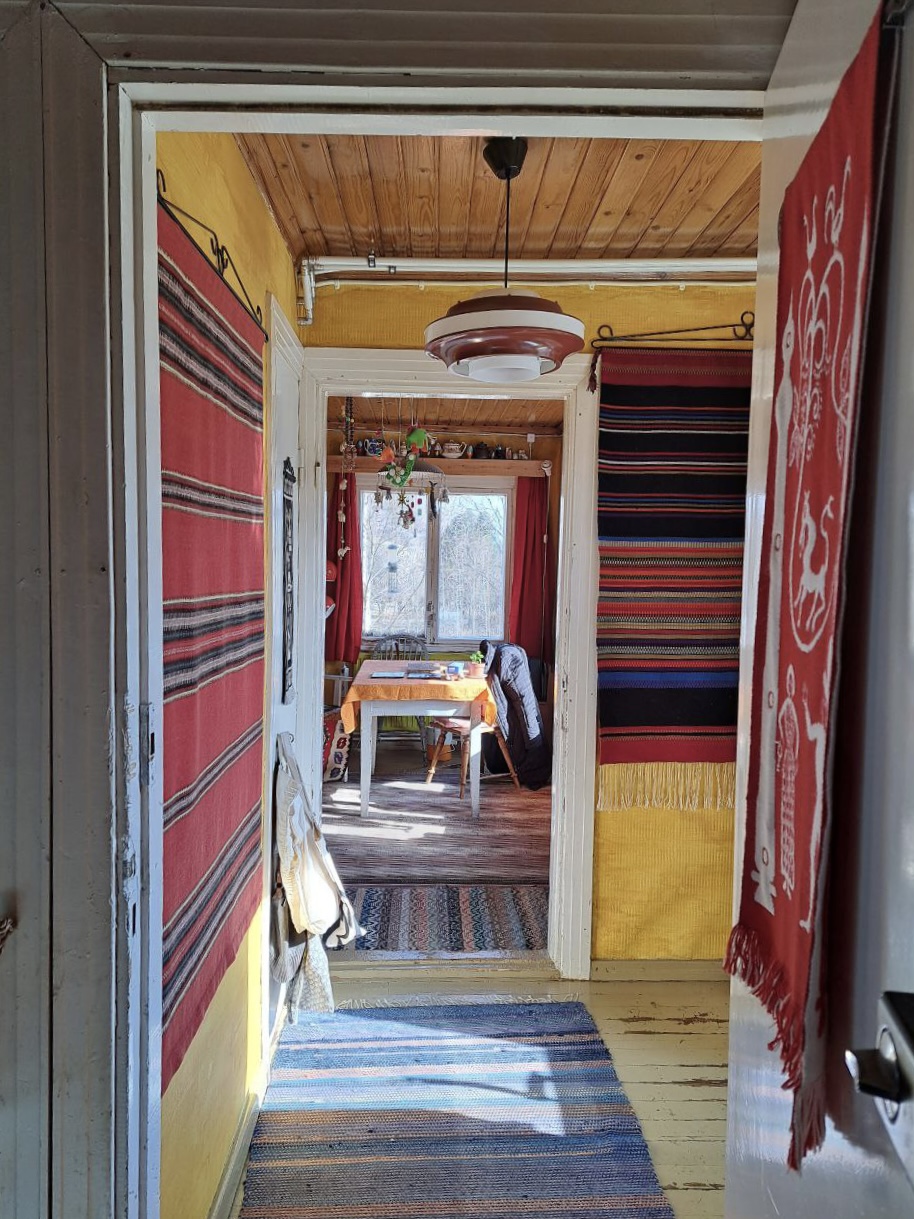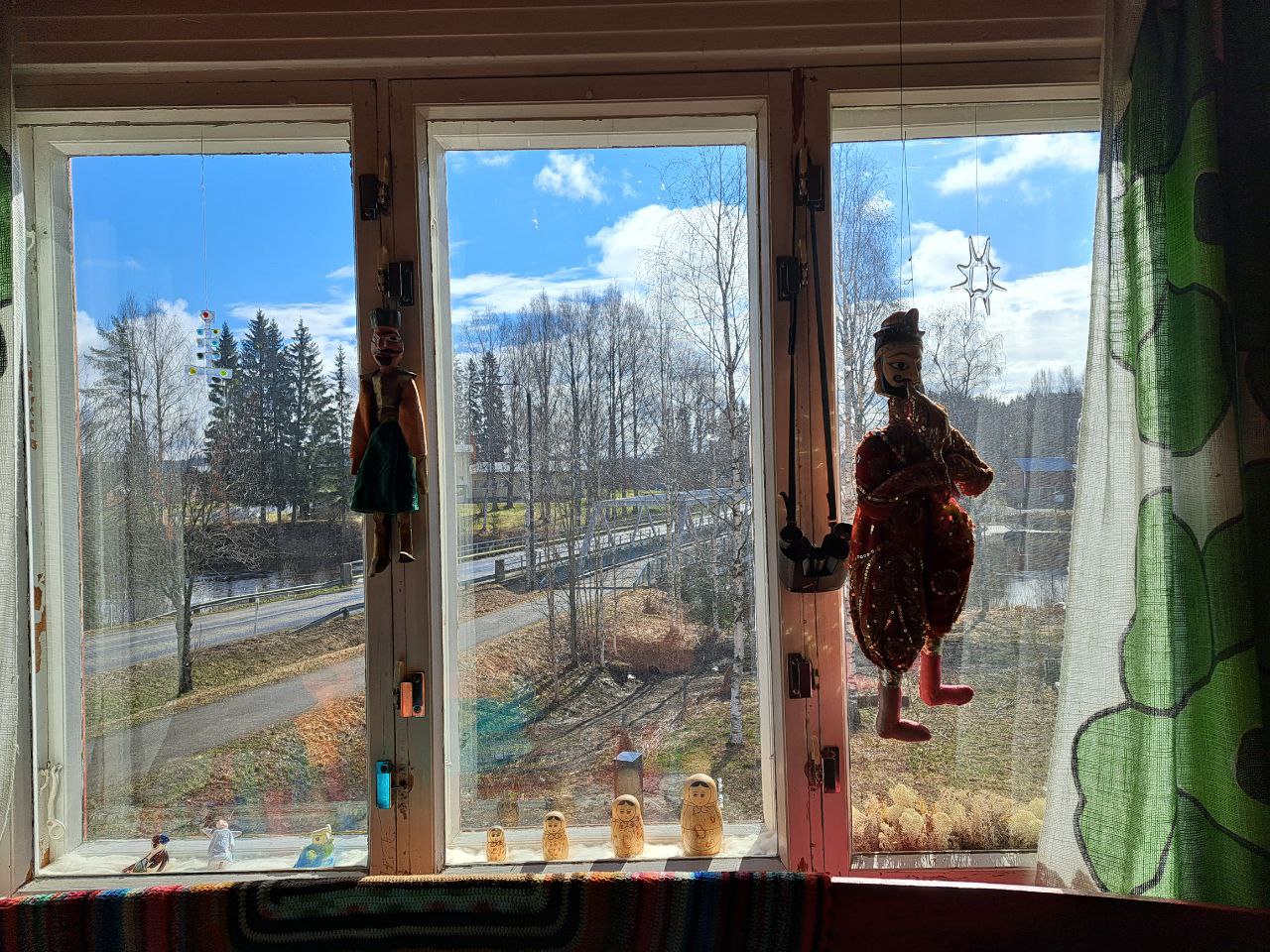Text and photo: Angelina Davydova

TRAVEL DIARY: VÄRTSILÄ
When Karoliina Arvilommi, a textile artist and creator of the Värtsilä Artist Residency, introduces herself, she says: “I live by the Russian border”.
As we drive to Värtsilä late in the evening, we see fields stretching all the way to the border, we see border police watchtowers on the hills, we see well-lit posters announcing border control points nearby.
We also see flocks of geese returning home, flying in V-formation. Later in the night we will hear the chirping and tweeting of migrating birds staying for the night in the wetlands by the river. They are very loud indeed.
We listen to them while standing quietly behind the bushes on unusually soft earth – it is covered in last year’s dried grass and moss. A lot of moss of various kinds and colors. Moss even lives on the rocks appearing out of the ground in this region.
Värtsilä, which is now a part of Tohmajärvi, is not only a border-settlement, it is also a settlement divided by the border. After the Winter War, the main part of Värtsilä with its machine building facilities and iron works became part of the Soviet Union, and the outskirts, mostly with family houses, remained Finnish. There is some agricultural activity in the area, with oats, barley and rye grown in the fields, as well as a few animal farms. Now Värtsilä is just a couple dozen houses, a library which was recently closed and sold as a private property, a theater which is only active during the summer months – in a red-walled wooden building. We see many houses like this in the area.
Karoliina’s home is a two-storied building with outside renovation still going on. Right by the river. The house used to be the town hall right after the war. Later a post office, bank, and shop. Karoliina Arvilommi has been living here for 20 years.

She has some previous experience of working with refugees – that time with artists from Afghanistan and Iraq. Karoliina is also someone who supports the idea of artists residencies as such – she suggested creating an artist residency in Tohmajärvi, and then the municipality launched a summer residency in the Musiikkiopisto ( “Music School”) open to all kinds of artists who could reside there from two weeks to one month. So far it has been mostly frequented by Finnish artists.
But she was also dreaming of having a year-round residency in the region.
When the war in Ukraine started, the local county offered apartments for refugees in Tohmajarvi. Karoliina suggested creating a residency in Vartsila for the Ukrainian artists in exile. So, the Finnish immigration service (Migri) and the municipality got together to provide financial and legal support: Migri pays the rent for the apartments, and electricity, while furniture, additional supplies, as well as costs of materials for the artists, are covered by the municipality.
At first the Värtsilä Artist Residency was located in Värtsilä town hall – the building is due to be demolished soon. Ukrainian artists getting support, lived in that building until November 2022 and later moved to new townhouses recently built in Värtsilä. The studios they work in are about two kilometers away.
At the moment there are three artists from Ukraine living in Värtsilä with their families: Nataliia Deineka, a naïve painter and an art teacher, Sergii Shaulis, a sculptor and Mari Zhiginas, a jazz singer and a teacher. Mari bakes very special chocolate-covered pastries with butter cream filling for our visit.
Karoliina reached out to several programmes to reach the Ukrainian artists. Since July 2022, the Värtsilä Artist Residency has been a part of the Ukraine Solidarity Residency programme (USRP). USRP supports artists with working grants and travel costs, as well as providing networking opportunities, workshops, visibility and possibilities to showcase their works in Finland.
Karoliina says that Vartsila is a good place for families. “Kids are happy here, (alone) individuals can feel too lonely and isolated”, she adds.
It is important to connect residents with the local community, she also says. Residents have Finnish classes twice a week, and there are other regular meetings with the community.
Speaking about the future of the initiative, Karoliina is hoping to find further support. She is continually reaching out to various organizations and programs supporting artists. Through social media she is also helping artists find exhibitions and other opportunities throughout Finland. For example, Mari got a grant from the municipality to start a choir, they will be practicing throughout May and have their first concert on the 3rd of June.
Karoliina hopes that if she secures financing, she could be able to run a “normal” residency and not an “emergency” residency. The experience of the last months has been rewarding, but so much more challenging than a “normal” residency. It is much harder to draw a dividing line between “personal” and “professional”, tough to turn your mobile phone off for the night, difficult to put limits on your involvement in running a residency (and not making it a 24 hours a day endeavor).

Karoliina thinks that the Finnish and Karelian experience of displacement following the Second World War has certainly affected the way the war in Ukraine is being perceived here. “People might feel more compassionate towards Ukrainians, they can relate better”, she says, remembering many people in the region whose families also lost their houses because of the war 80 years ago. The border is close.
Karoliina, and pretty much everyone we met in the region say that before the war they used to go to Russia regularly and had friends there. Now many of their Russian friends and colleagues, from Sortavala, St.Petersburg and other places also decided to leave their country because of the war in Ukraine, and because of their anti-war position. Karoliina’s friends went to Canada, Montenegro, and other countries. The border crossing point in Värtsilä is officially open, but very few people are using it.